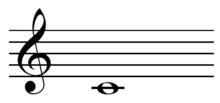C (musical note)

In terms of musical pitch, C or Do is the first note of the fixed-Do solfège scale. Its enharmonic is B♯ (B-sharp, His in some European countries), which is by definition a diatonic semitone below C♯.
Middle C
When the A440 pitch standard is used to tune a musical instrument, Middle C has a frequency around 261.6 Hz. Middle C is designated C4 in scientific pitch notation because of the note's position as the fourth C key on a standard 88-key piano keyboard.
Another system known as scientific pitch assigns a frequency of 256 Hz but, while numerically convenient, this is not used by orchestras. Other note-octave systems, including those used by some makers of digital music keyboards, may refer to Middle C differently. In MIDI, Middle C is note number 60.
The C4 designation is the most commonly recognized in auditory science, and in musical studies it is often used in place of the Helmholtz designation c'.
While the expression "Middle C" is generally clear across instruments and clefs, some musicians naturally use the term to refer to the C note in the middle of their specific instrument's range. C4 may be called "Low C" by someone playing a Western concert flute, which has a higher and narrower playing range than the piano, while C5 (523.251 Hz) would be Middle C. This technically inaccurate practice has led some pedagogues to encourage standardizing on C4 as the definitive Middle C in instructional materials across all instruments.[1]
In vocal music, the term Soprano C, sometimes called "High C" or "Top C," is the C two octaves above Middle C. It is so named because it is considered the defining note of the soprano voice type. It is C6 in scientific pitch notation (1046.502 Hz) and c''' in Helmholtz notation. The term Tenor C is sometimes used in vocal music to refer to C5, as it is the highest required note in the standard tenor repertoire. The term Low C is sometimes used in vocal music to refer to C2 because this is considered the divide between true basses and bass-baritones: a basso can sing this note easily while other male voices, including bass-baritones, cannot.
In organ music, the term Tenor C can refer to an organ builder's term for small C or C3 (130.813 Hz), the note one octave below Middle C. In stoplists it usually means that a rank is not full compass, omitting the bottom octave.[2]
For the frequency of each note on a standard piano, see piano key frequencies.
Designation by octave
| Scientific designation | Helmholtz designation | Bilinear music notation | Octave name | Frequency (Hz) | Other names | Audio |
|---|---|---|---|---|---|---|
| C-1 | C͵͵͵ or ͵͵͵C or CCCC | (-uC) | Subsubcontra | 8.176 | ||
| C0 | C͵͵ or ͵͵C or CCC | (-vC) | Subcontra | 16.352 | ||
| C1 | C͵ or ͵C or CC | (-wC) | Contra | 32.703 | ||
| C2 | C | (-xC) | Great | 65.406 | Low C | |
| C3 | c | (-yC) | Small | 130.813 | Bass C, Tenor C (organ) | |
| C4 | c′ | (zC) | One-lined | 261.626 | Middle C | |
| C5 | c′′ | (yC) | Two-lined | 523.251 | Tenor C (vocal), Treble C | |
| C6 | c′′′ | (xC) | Three-lined | 1046.502 | Soprano C (vocal), High C (vocal), Top C (vocal) | |
| C7 | c′′′′ | (wC) | Four-lined | 2093.005 | ||
| C8 | c′′′′′ | (vC) | Five-lined | 4186.009 | Eighth octave C | |
| C9 | c′′′′′′ | (uC) | Six-lined | 8372.018 | ||
| C10 | c′′′′′′′ | (tC) | Seven-lined | 16744.036 |
Graphic presentation


Scales
Common scales beginning on C
- C Major: C D E F G A B C
- C Natural Minor: C D E♭ F G A♭ B♭ C
- C Harmonic Minor: C D E♭ F G A♭ B C
- C Melodic Minor Ascending: C D E♭ F G A B C
- C Melodic Minor Descending: C B♭ A♭ G F E♭ D C
Diatonic scales
- C Ionian: C D E F G A B C
- C Dorian: C D E♭ F G A B♭ C
- C Phrygian: C D♭ E♭ F G A♭ B♭ C
- C Lydian: C D E F♯ G A B C
- C Mixolydian: C D E F G A B♭ C
- C Aeolian: C D E♭ F G A♭ B♭ C
- C Locrian: C D♭ E♭ F G♭ A♭ B♭ C
Jazz Melodic Minor
- C Ascending Melodic Minor: C D E♭ F G A B C
- C Dorian ♭2: C D♭ E♭ F G A B♭ C
- C Lydian Augmented: C D E F♯ G♯ A B C
- C Lydian Dominant: C D E F♯ G A B♭ C
- C Mixolydian ♭6: C D E F G A♭ B♭ C
- C Locrian ♮2: C D E♭ F G♭ A♭ B♭ C
- C Altered: C D♭ E♭ F♭ G♭ A♭ B♭ C
B sharp

Twelve just perfect fifths (B♯) and seven octaves do not align as in equal temperament.
- Pythagorean: 701.955 × 12 = 8423.46 = 23.46 = B♯+++
- ET: 700 × 12 = 8400 = 0 = B♯ = C
- 1200 × 7 = 8400 = 0 = C
This difference, 23.46 cents (531441/524288), is known as the Pythagorean comma.
See also
References
- ↑ Large, John (February 1981). "Theory in Practice: Building a Firm Foundation". Music Educators Journal 32: 30–35.
- ↑ Wakin, Daniel J. (2007-09-09). "The Note That Makes Us Weep". New York Times. Retrieved 2007-12-12.
| ||||||